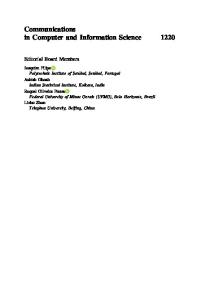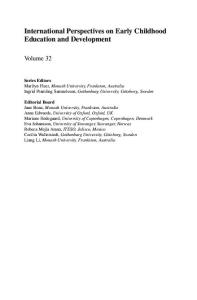Chinese Literacy Learning in an Immersion Program
This book examines one-way foreign language immersion education in the United States. It provides a clear and rich description of a Chinese (Mandarin) immersion program, its curriculum, instructional materials, assessment activities, parental involvement
- PDF / 3,316,534 Bytes
- 263 Pages / 433.701 x 612.283 pts Page_size
- 35 Downloads / 393 Views
CHAN LÜ
Chinese Literacy Learning in an Immersion Program “In this compelling and deeply researched volume, Chan Lü describes and investigates the complexities surrounding bi-literacy development in English and Chinese. Employing a case-study approach that focuses in detail on the workings of a U.S. Chinese immersion school, Lü’s chapters supply a support structure to guide the reader through the issues impacting bi-literacy development in languages employing strikingly different writing systems. Those uninitiated in immersion education or Mandarin Chinese language will welcome the chapter on the history and growth of immersion programs in the United States, and the in-depth description of the Mandarin Chinese language orthographic and sound structure and how they influence literacy development. Literacy educators and researchers of all stripes will welcome the theoretical chapter on the foundations of reading, and the review of bi-literacy research in immersion settings; those interested in how literacy develops in speakers of Chinese as a first or second language will find the most up-to-date research sources available, and gain greater insight into contentious pedagogical issues such as the use of pinyin. Moreover, Lü includes new research studies that focus on how oral language, phonological awareness and word reading relate to 2nd graders’ reading comprehension, and how morphological awareness, vocabulary knowledge, and lexical inference relate to text comprehension for 3rd graders. The volume particularly shines in concluding what the implications are for vocabulary development, program level practices, and pedagogical materials development, with a future research agenda that will challenge scholars for years to come. Importantly, the volume captures the challenges of Mandarin immersion education as expressed through the voices of the dedicated teachers in the trenches, thus putting a personal perspective on the serious challenges facing teacher education. This is a volume that all stakeholders in Chinese literacy and second language/immersion education will want close at hand.” —Michael E. Everson, Emeritus Associate Professor of Foreign Language Education, University of Iowa, USA “In 2018, we find ourselves at a point in the history of the Chinese language teaching profession in the United States where 90% of students studying the language and culture in the PreK-16+ academic pipeline are doing so at the
pre-collegiate level – and over 45% in K-12 programs. The urgency of designing better immersion programs in those primary and secondary schools is of paramount importance. Dr. Lü is to be highly commended for providing both a macro-analysis of the American language education theoretical and empirical context wherein programs such as Pacific Elementary School have been established, and a micro-level examination of how such a program may be better understood and enhanced. For program administrators to front-line teachers, and for literacy scholars to language policy advocates, this is a book of great insi
Data Loading...











